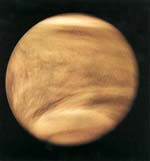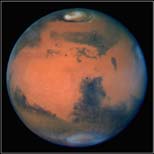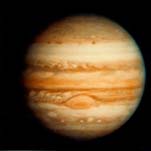|
Life is a matter of physical forces and chemical reactions. We cannot
yet define these "right conditions" with assurance, and
the prime reason for the unmanned probes of Venus and Mars has been
to search for some other form of life, and to give us more data
on the limits within which life can evolve.
We are apparently out of luck with Venus, which has surface temperatures
close to that of molten lead. Mercury is a lifeless ball of rock
baked by the sun.
Mars is our best remaining hope as a home for extraterrestrial life,
although it apparently is a dry, cold, and relatively inhospitable
planet. We can imagine life surviving under present Martian conditions
(even human life), but it is hard to imagine it evolving under such
conditions. Perhaps Mars was a quite different planet earlier in
its history.

Venus
|
 Mars
Mars |
|
|
Jupiter is rich in hydrogen, with lesser amounts of ammonia and
methane, and it is not ridiculous to imagine liquid ammonia as a
medium for life there instead of water. But we have no data or experience
to make this more than pure speculation. Even this would still be
"second-shell" life, using the same group of chemical
elements as on Earth.
Beyond Jupiter, the low temperatures and resulting slowdown in chemical
reactions make life hard to imagine. All that we can say is that,
wherever life is found, we would expect it to be based on the firstand
second-shell elements, hydrogen through fluorine.
Whether there is more than one pattern of reactions or choice of
elements for life within this range, is impossible to say.
 Jupiter
Jupiter |
|